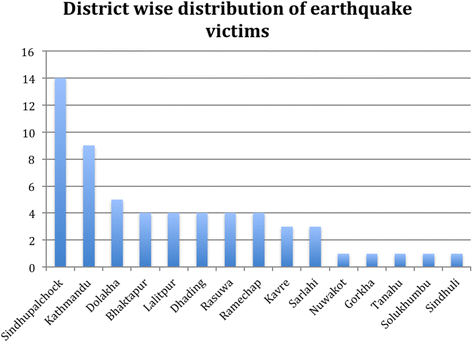The impact of ocular trauma during the Nepal earthquake in 2015
- PMID: 28351353
- PMCID: PMC5371192
- DOI: 10.1186/s12886-017-0429-z
The impact of ocular trauma during the Nepal earthquake in 2015
Abstract
Background: Nepal was struck by a massive earthquake on the 25th April 2015 and major aftershock on the 12th of May 2015, resulting in widespread devastation with a death toll in the thousands. The burden of ocular trauma resulting from the recent earthquakes in Nepal has not been described thus far. The aim of this study was to determine the types of ocular injuries sustained in the earthquake in Nepal and its management in Tilganga Institute of Ophthalmology (TIO) in Gaushala, Kathmandu.
Methods: This is a hospital-based retrospective study of patients presenting to TIO following repeated earthquake. Variables that were recorded included patients' presenting symptoms and time to presentation, visual acuities at presentation and at follow-up, diagnosis of ocular injury and surgery performed.
Results: There were 59 cases of earthquake victims visiting TIO, Gaushala, Kathmandu from April 2015 to July 2015, with 64 affected eyes due to 5 cases of bilateral involvement. The majority of patients were from the district Sindhupalchowk (14 cases, 23.7%), which was the epicenter of the main earthquake. The average duration between the earthquake and presentation was 13 · 9 days (range 1-120 days). Closed globe injury was most frequent (23 cases), followed by open globe injuries (8 cases). While 24 patients (38%) initially presented with a visual acuity <3/60 in their affected eye, 15 patients (23%) had a visual acuity of <3/60 on follow-up. A variety of surgical treatments were required including anterior and posterior segment repair.
Conclusions: Immediate management of ocular trauma is critical in order to prevent blindness. Characterizing the burden of earthquake-related ocular trauma will facilitate planning for service provision in the event of a future earthquake in Nepal, or in countries, which are similarly at risk of having natural disasters.
Keywords: Closed globe injury; Earthquake; Ocular Trauma.
Figures
Similar articles
-
Pattern of ocular trauma in the western region of Nepal.Nepal J Ophthalmol. 2012 Jan-Jun;4(1):5-9. doi: 10.3126/nepjoph.v4i1.5843. Nepal J Ophthalmol. 2012. PMID: 22343989
-
Causes of combat ocular trauma-related blindness from Operation Iraqi Freedom and Enduring Freedom.J Trauma Acute Care Surg. 2015 Oct;79(4 Suppl 2):S210-5. doi: 10.1097/TA.0000000000000666. J Trauma Acute Care Surg. 2015. PMID: 26131785
-
Chest Trauma Requiring Admission: Differences in Earthquake Victims and other Modes of Injury.Kathmandu Univ Med J (KUMJ). 2018 Jul-Sept.;16(63):237-239. Kathmandu Univ Med J (KUMJ). 2018. PMID: 31719313
-
The global impact of eye injuries.Ophthalmic Epidemiol. 1998 Sep;5(3):143-69. doi: 10.1076/opep.5.3.143.8364. Ophthalmic Epidemiol. 1998. PMID: 9805347 Review.
-
Epidemiological patterns of ocular trauma.Aust N Z J Ophthalmol. 1992 May;20(2):95-8. doi: 10.1111/j.1442-9071.1992.tb00718.x. Aust N Z J Ophthalmol. 1992. PMID: 1389141 Review.
Cited by
-
Ocular morbidity in natural disasters: field hospital experience 2010-2015.Eye (Lond). 2018 Nov;32(11):1717-1722. doi: 10.1038/s41433-018-0167-3. Epub 2018 Jul 9. Eye (Lond). 2018. PMID: 29988071 Free PMC article.
-
Ocular Trauma among Patients Visiting the Outpatient Department of Ophthalmology in a Tertiary Care Centre.JNMA J Nepal Med Assoc. 2023 Dec 1;61(268):907-910. doi: 10.31729/jnma.8368. JNMA J Nepal Med Assoc. 2023. PMID: 38289755 Free PMC article.
-
Integrating specialist ophthalmic services into emergency medical teams.Bull World Health Organ. 2020 Oct 1;98(10):722-724. doi: 10.2471/BLT.20.255786. Epub 2020 Sep 3. Bull World Health Organ. 2020. PMID: 33177762 Free PMC article. No abstract available.
References
-
- World Health Organisation. Nepal earthquake 2015 - Grade 3 emergency. <http://www.who.int/emergencies/nepal/en/> (date visited 14 Jan 2016)
-
- Yaba Lago.Vision A Regional Resource Centre for Community Eye Health/Prevention of Blindness. Vision 2020. Regional Newsletter. 2006;2:5.
MeSH terms
LinkOut - more resources
Full Text Sources
Other Literature Sources
Medical
Miscellaneous


